“Mommy, Where Do Doctors Come From?”
Training to become a physician, whether one aspires to be a Medical Doctor (MD) or Doctor of Osteopathic Medicine (DO), takes many years, including undergraduate, graduate, and post-graduate study. The length of time it takes one to complete training will vary by specialty. Most physicians will finish their training in eleven years starting with their undergraduate work. Fortunately, doctors in training do not have to worry about their medical liability as they are covered by the universities and the hospitals medical malpractice insurance during their training.
First, One Must Obtain an Undergraduate Degree
Some students may finish their undergraduate degree in three years, but most will complete their degree in four years. Most colleges and universities will offer a pre-medicine (pre-med) focus to students interested in pursuing medical school. As a pre-med student, one will work toward earning their Bachelor of Arts or Bachelor of Science degree. The major one chooses does not need to be in sciences, but it is helpful. Medical school also requires a strong knowledge of biology and chemistry. No matter the major, pre-med students should be sure to add classes in math and various sciences to their schedule in order to learn the necessary basics.
Second, One Must Attend a Medical School
After receiving a Bachelor degree, one will become eligible for admittance into the medical school of one’s choice. This part of the journey to become a physician or surgeon will typically last for four years. During the first two years of medical school one will spend most time in the classroom and labs studying anatomy, physiology, biology, medical laws and ethics, etc. Within the final two years of medical school, students will spend their time shadowing practicing physician’s during clinical rotations. During rotations one will have the opportunity to experience what life is like working in various specialties including – General Practice, Pediatrics, Internal Medicine, Psychiatry and Surgery. This experience will help medical students determine how they want to specialize as they move forward in their training. While medical students complete their training, medical malpractice insurance claims do happen from time to time. Most universities are self insured for such exposure therefore; medical students are covered for their medical liability.
The next step in becoming a physician or surgeon includes completing a Residency and/or Fellowship
After completing and graduating from medical school one must enter a residency program. Residency training will last anywhere from three to six years, dependent upon how one chooses to specialize. Residency training will offer hands-on paid training, usually at a hospital, and always under supervision of other more senior physicians. As a resident, one will see patients, write prescriptions for medications and work in various areas of the hospitals. Surgical specialties are highly competitive and typically only the students who ranked highest in their classes will go on to surgical residency. Upon completion of the residency one will have the option of further specializing by completing a fellowship. Fellowships will last about one to three years and will allow one to specialize in child Psychiatry, Neonatology, Oncology, Gastroenterology, among many others. As an example, on of the most common specialties for primary care is internal medicine. Internal medicine trained physicians who wish to specialize in Cardiology, go on to complete a fellowship in Cardiology. Many physicians who have trained in Anesthesiology wish to also specialize in Pain Management and will complete a one or two year fellowship.
Similar to medical school medical liability insurance claims are not common for residents although they do happen. They are more common than medical student malpractice claims. Residents are covered by their hospitals/residency programs for their medical malpractice insurance.
After completion of the Residency and/or Fellowship freshly trained physicians must obtain a license. Acquiring a license can be done during residency as well. All physician’s, must hold a license to legally practice medicine in the United States. Each state has its own licensing board to which physicians apply for a medical license. Some states require physicians to have medical malpractice insurance in place if they wish to have a license in their state. The medical license board will require the physician to provide a certificate of insurance from their medical liability insurance company. Physicians are also required to take CME’s (continuing medical education) in order to renew their license.
Finally, as a licensed, new-to-practice physician or surgeon one will need to find a job. According to the Bureau of Labor Statistics, physicians and surgeons held about 661,440 jobs in 2008; approximately 12% were self-employed, 53% of physicians and surgeons worked in physician offices, and 19% were employed by hospitals. The remaining physicians and surgeons practiced in Federal, State and local governments, educational services and outpatient care centers.



